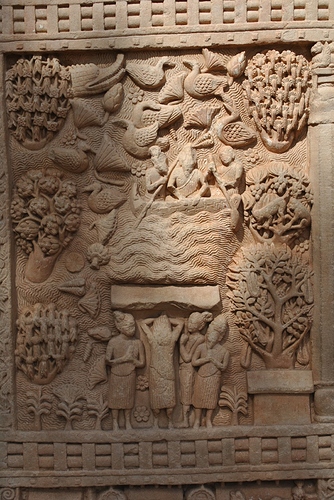I understood your question to be why were monks behaving in certain ways, and I tried to answer it based on the vinaya and Thai customs. I apologize if I misunderstood you in any way.
The origin story for the rule about not wearing householder’s upper garments is located here - SuttaCentral.
The vinaya states that the group of six wore lay upper garments, which caused lay people to talk poorly of the sangha, saying they were like householders who enjoy the pleasures of the senses. To prevent this issue from arising again, the Buddha instituted the rule.
The vinaya texts are clear on how the rules were developed - on a case by case basis as problems and questions arose. The Buddha had to change the precepts constantly because of new circumstances. For instance, in the Vinaya the section regarding umbrellas (or sunshades) starts off like this -
Now at that time a sunshade accrued to an Order. They told this matter to the Lord. He said: “I allow, monks, a sunshade.”
And like that the Buddha allowed them. But then this happened:
Now at that time the group of six monks toured about having put up their sunshades. Now at that time a certain lay-follower went to a pleasure grove together with several disciples of Naked Ascetics. These disciples of Naked Ascetics saw the group of six monks coming in the distance with their sunshades up; seeing them, they spoke thus to that lay-follower: “These revered sirs of yours, master, are coming along with their sunshades up like a group of chief ministers.”
“These, masters, are not monks, they are wanderers.” They made a bet as to whether they were monks or not. Then that lay-follower, having recognised them as they came up, looked down upon, criticised, spread it about, saying: “How can these revered sirs tour about with their sunshades up?” Monks heard that lay-follower who … spread it about. Then these monks told this matter to the Lord. He said: “Is it true, as is said, monks, …?”
“It is true, Lord.” Having rebuked them, having given reasoned talk, he addressed the monks, saying:
“Monks, a sunshade should not be used. Whoever should use one, there is an offence of wrong-doing.”
And umbrellas were no longer allowed. However, a new situation arose:
Now at that time a certain monk came to be ill; there came to be no comfort for him without a sunshade. They told this matter to the Lord. He said: “I allow, monks, a sunshade to one who is ill.”
Yet another change to the rule based on circumstances arising. And yet again, a new circumstance arose -
Now at that time monks, thinking: “A sunshade is allowed by the Lord to one who is ill, but not to one who is not ill,” were doubtful whether to use a sunshade in the monastery and monastery precincts. They told this matter to the Lord. He said: “I allow, monks, a sunshade to be used in a monastery and monastery precincts both by one who is ill and by one who is not ill.”
And that’s where the rule was left to this day.
I bring this up to point out that the rules were not created from the ability to see the future or omniscience. According to the vinaya the Buddha had to change the rules many times. It also tells us that the Buddha allowed the monks to remove the minor rules - indicating that even if it is a good idea for monks to continue to follow them, many of the rules are not essential for noble practice. Maha Kassapa suggested the sangha continue to keep all the rules because failing to do so would bring the sangha into disrepute with the lay people. They didn’t keep the minor rules because all of the rules were necessary or important - they kept them because failing to do so would cause them to be criticized by the lay community.
The vinaya was largely developed in response to lay people’s criticism of various groups of ill-behaved bhikkus and disputes that arose within the sangha. That isn’t to say that the lay people can pick the rules - I just want to point out that vinaya was often a matter of a give-and-take between the lay and monastic communities. Any question of behavior has to be looked at in conjunction with the larger circumstances of the communities, particularly what is conducive for monks and lay people living in harmony.
Going back to the present and the rule I brought up about sunshades. Monks holding beautifully crafted umbrellas seem to be common in Myanmar (you would know better than I would). But the rule says umbrellas are only allowable for sick monks and within monasteries! Meanwhile, monks holding umbrellas as a sunshade are rarely seen in Thailand. They are usually only used as a protection against rain or to hold a mosquito net up. Why? In Myanmar, the tradition is that feeling hot because of the sun counts as sickness, so monks can use an umbrella as a sunshade whenever they want. But in Thailand, most monks do not consider feeling hot to be sickness, thus they do not use them as a sunshade.
Most of the rules are to help the sangha live in harmony with each other and the lay people. Learning to live in harmony with others is far more important than learning the details of these sorts of rules unless you are a monk who is being taught them.
I can’t emphasize this point enough. I’ve read several long books explaining all of the vinaya rules and procedures in great detail, but it has not benefited me or the monks I associate with. Whenever I have needed to know about a rule to better interact with monks, I can ask a monk in that community.
I hope this is helpful to you in some way!




